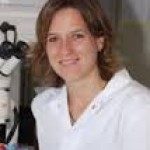Lien vers Pubmed [PMID] – 28386027
Lien DOI – 10.1126/science.aai7407
Science 2017 May; 356(6337):
The emergence of spatial patterns in developing multicellular organisms relies on positional cues and cell-cell communication. Drosophila sensory organs have informed a paradigm in which these operate in two distinct steps: Prepattern factors drive localized proneural activity, then Notch-mediated lateral inhibition singles out neural precursors. Here we show that self-organization through Notch signaling also establishes the proneural stripes that resolve into rows of sensory bristles on the fly thorax. Patterning, initiated by a gradient of Delta ligand expression, progresses through inhibitory signaling between and within stripes. Thus, Notch signaling can support self-organized tissue patterning as a prepattern is transduced by cell-cell interactions into a refined arrangement of cellular fates.


